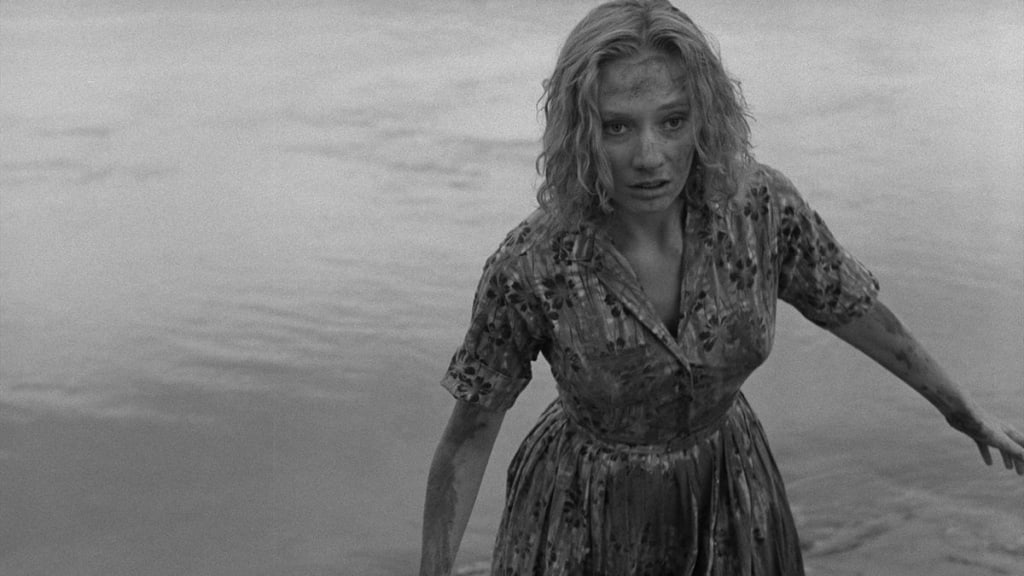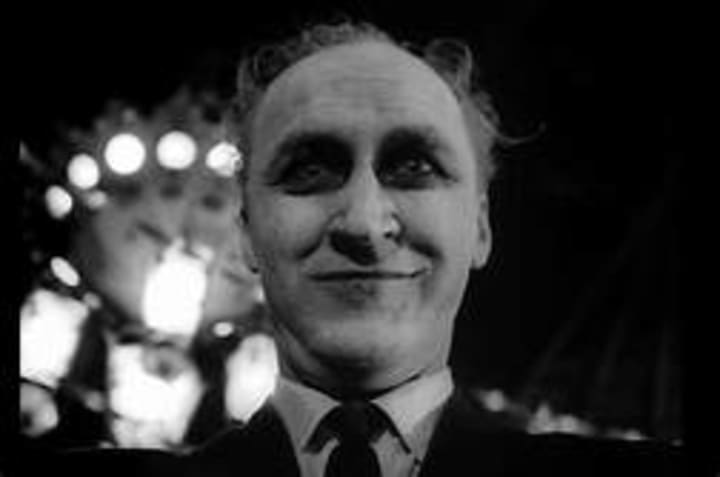
Carnival of Souls starts with one indelible, haunting image: that of actress Candace Hilligoss (who plays Mary) crawling, dripping and dazed, from the waters of a river into which the car she is riding in has just fallen. She makes her way slowly to a sandbar beneath the bridge, her arms extended at her sides awkwardly. She is nearly dead-center in the eye of the viewer, an image worthy of a night's troubled dreams, when rescuers come forward from left and right. It is as if she is outside herself dreaming the image of herself being saved from a watery grave.
From there, Carnival of Souls begins one long, creeping, spiraling descent into hallucinatory madness. It's a "haunted" film that, like Eraserhead, evokes deep feelings of disorientation; yet, somehow, also evokes subconscious familiarity from the viewer--as if he or she were witnessing a cinematic apparition usher forth; Carnival is a film that could just as easily have been made in the silent era; much of the film is without dialog, and scenes are visual waltzes of spectral revenants, paranoia and the fear of what is lurking just around the corner.
Mary is then seen walking the wooden bridge where the accident occurred; the movie began with two punks drag racing Mary and her girlfriend; the punks are a couple of JD types that seem typical of the era when young toughs were called "greasers." Mary and her friend are crowded off the bridge, into the water. Mary seems to be visiting this spot now to remember the trauma, her girlfriend that didn't survive.
We then see her at an organ factory--she plays the organ and is, apparently, leaving town because she has been hired at a church in another city. She plays an immense pipe organ expertly. When her boss (Tom McGinnis) comes out to comment on the beauty of her playing, we get a glimpse of the detached, aloof, and reclusive nature of her personality. "That's not the kind of attitude for someone going into church service," he warns her. She replies, "I'm just gonna play the organ. I'm not taking the vows."
A jump-cut of her hands on the keys of the organ to the front seat of her car begins the weird, dream-like quality that marks the rest of the film. Driving through the country toward her new job, her new life, she finds static on the radio. In the reflection in the window on the passenger side, she sees (or imagine she sees) a strange face. It is The Man (director Herk Harvey), a pale, grinning, corpse-like character with dark circles under his eyes.

Sure she must simply be seeing things, she shrugs off the weird illusion. She rents a room from Mrs. Thomas (Frances Feist) in a large, echoing, spooky old house where the only other tenant is the seedy Mr. Linden (Sydney Berger), who works at a warehouse and is an alcoholic. He has a kind of rat-like, oily charm, and tendencies to being a voyeur and sex obsessed. He introduces himself right off the bat, after stealing a glimpse of Mary disrobing through a cracked doorway. He speaks in the greaser argot of the era.
There is something distinctly dislikable about him; he drinks before his warehouse job, and speaking with Mary in her room, makes somewhat lewd suggestions while she chides him on his shortcomings. She's a "cold fish" he realizes, but that isn't the end of it.
Mary soon begins to realize that, often, normal people seem not to be able to see or hear her. Is she going mad? She likewise begins to see The Man everywhere, the same recurrent phantom, and the audience is left to wonder what is real, and what is simply a product of a neurotic woman's worsening mental state.
Playing the organ for the minister (Art Ellison), she informs him of the curious sight she saw driving into town--an abandoned amusement park. Together, the minister and Mary go to visit the deserted place, standing just outside the gates. She feels compelled to enter, and asks him if he would take her inside. "No," he laughs. "The law has put it off-limits. It wouldn't be very seemly for a minister to break the law, would it?"
Regardless, he seems satisfied enough with her organ playing, although, when she rebuffs his offer to meet the congregation, he sternly reminds her that, "You cannot live in isolation from the human race, you know."
Her descent into fear seems to deepen, and she begins to see The Man at every turn. She has visions of him, along with similar phantoms, emerging from a watery grave. Playing organ in the church one evening, she hallucinates that she is at the abandoned amusement park pavilion, with The Man and the many strange, black-eyed phantoms accompanying him dancing, dancing to the wild, free, nearly occult music pouring forth from her fingers.
Faster and faster they twirl, making a hideous mockery of actual human dance, of perambulations that would even be physically possible. Instead, they are an absurd image from a nightmare, and they break apart from their death waltz, pursuing Mary, to her terror.
The movie proceeds with its dark, troubled dream, it's sense of a suffocating net being wound about our heroine. Boarding a bus, Mary realizes that the fellow passengers are all the same pale, black-eyed ghosts, rising from their seats to pursue her, lead by The Man, who always has the slightest, smirking grin on his lips, as if the prey he is pursuing is deceptively simple to warren.
Mary goes to see a mental health professional, some sort of counselor that reminds her he is not, actually a doctor. The whole scene is obscure. The second time, she confesses her present neurosis to him while his back is turned. Turning around, she realizes she has been confessing her growing sense of nightmarish fear to the grinning Man himself. She runs, again, pursued by the creeping tide of nameless terrors that seem to accost her everywhere, at every turn.

Some jump-cuts suggest moving, with the speed of a shifting dream, from one state of being to another. Looking for a possible emotional and psychological anchor, then, Mary seeks out a date with Linden. After a night of drinking in which she seems uncomfortable, he tries to convince her to let him stay the night. Instead, she sees the image of The Man in the mirror, and he leaves her room in disgust, convinced that she's crazy. Perhaps she is, or, at the very least, is well on her way there.
She ends at the pavilion in the abandoned amusement park. Now, she has been transformed into one of the pale, black-eyed revenants. Now, she is dancing with The Man, a death waltz, two lovers, caught in a supernal, yet sepulchral moment in time. He has emerged from his watery grave, along with the others. Why are they trying to claim her?
Pursued by flying phantoms, she races out to the beach, where her footprints, the tangible evidence that she was here, disappear into the surf. The next day, in the gray, trickling light of watery dawn, the minister and a few others come out looking for Mary. They find no corpse. No body.
Far away, the car that fell from the bridge at the beginning of the picture has a body in it. Mary's body. She never left that car after all. She died alongside her friend, drowned. What of the rest of it? Was it her dying vision of what could have been? The viewer familiar with classic American ghost stories may well remember Ambrose Bierce's "An Occurrence at Owl Creek Bridge," in which a doomed Confederate saboteur is hanged from a bridge. His rope breaks, and he swims to safety, back into the arms of his loving wife, who has been waiting for him to return home all this time.
Rushing into her arms, he realizes that this is all illusion; a death-dream. His body is hanging suspended back on that bridge, the noose snapped tightly around his neck. These were his dying visions, his "Could Have Been."
Alternately, an even stranger metaphysical truth is hinted at. It seems to beg the question: Can we not exist in parallel realities, two different worlds? If we die before our fated, allotted years, can we not, somehow, simultaneously experience both? Doesn't quantum physics speculate the existence of alternate worlds, of an alternate You and I, somewhere evolved as the law of probabilities demands, amid the quintillion star vastness of incalculable space and time? Or perhaps these alternate dimensions exist next door. Perhaps, like the "Twilight Zone" intimated, we can round a corner and end up in the "fifth dimension"; a place of shadow and yet "...of substance." An old episode of that famous show had a doppelganger "invade" the life of a woman from a mirror reality, just beyond. Is this at the heart of Carnival of Souls?
After all, we find at the end that Mary was actually dead. She waltzed, though, with The Man, was dogged by him and his army of threatening, phantasmal invaders, who swam up, emerging from the nightmare waters, ghosts beckoning her, coming forth to claim her.
What of her time in the rooming house? With the minister? Linden? The Doctor (played by Stan Levitt)? Were any of these objectively "real"? A delusion? An alternate "life"(albeit, one snuffed out equally too soon)? Is she a ghost?
The Man is a living, grinning representation of the Id, of all she fears. And the invasion of ghosts, drowned, coming up from the watery death below, illuminated by the moon, is the threat of the grave come 'round. They dance, and she dances with them, round and round, faster and faster in one scene, as if each revolution were ticking off the minutes of a clock; as if they were simply a mechanism of time and the cosmos itself. One is reminded of Poe: "The Masque of the Red Death." And, also the old quote, "Those that danced were thought insane by those who could not hear the music." *
What is a dream? What is reality, and what illusion? Do ghosts continue, not knowing they're gone? Troubling ruminations.
Made for just thirty-thousand dollars, Carnival of Souls is a legend as far as films go. In a sense, it is beyond mere entertainment: it's a film that will haunt your sleep, disturb your thoughts, trouble your consciousness. If you allow it entry, much like the weird, black-eyed revenants that haunt Mary, you will forever be seeing the truth of it behind the facade. Because cinema is a dream awake, and horror films are rehearsals for a death that has, as of yet, not darkened our doorways. But, we dance onward, regardless, knowing that, much as Mary discovered, the dance will end one day; the credits will roll, when the music's over, and the "...Red Death held sway over all."
*Friedrich Nietzsche
Carnival of Souls is in the public domain, and can be viewed in its entirety for free.
About the Creator
Tom Baker
Author of Haunted Indianapolis, Indiana Ghost Folklore, Midwest Maniacs, Midwest UFOs and Beyond, Scary Urban Legends, 50 Famous Fables and Folk Tales, and Notorious Crimes of the Upper Midwest.: http://tombakerbooks.weebly.com






Comments
There are no comments for this story
Be the first to respond and start the conversation.